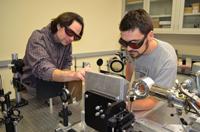
Pushing Technological and Geographical Boundaries in Pursuit of Excellence
Engineering physics major Bryan Berggren '16 is careful to wear his special laser goggles when entering the lab. He works as a student research assistant to Associate Professor of Physics Chris Weber, and together they are pushing new technological boundaries. Their main tool is a sophisticated titanium sapphire laser. “We test different samples of semiconducting materials. By shooting the electrons on their surface with our laser, we’re able to study their behavior in their excited and relaxed states. This allows us to better understand the electronic and magnetic properties of the materials, potentially leading to new applications down the road. Our upcoming trip to Okinawa will allow us to learn even more,” says Bryan.
The research is made possible by a $190,000 grant from the National Science Foundation that Weber obtained in 2011. Thanks to this support, he is able to hire two to three students who work with him at any given time during the school year. “I really enjoy seeing students go from knowing little about a subject to knowing a lot. I enjoy seeing them move on to satisfying jobs or graduate programs, and eventually accomplish great things on their own.”
Bryan, who works up to 14 hours per week in the lab during the school year and full time during the summer, sees the benefit of this experience. “My work here really complements what I learn in class, and vice-versa. For instance, I had to build an electronic device to help in our research, and I was able to put it together using what I had learned in Physics 70 [Electronic Circuits for Scientists]. It wasn’t easy and it took a lot of tries, but it was very rewarding and fun.”
Recently, Weber’s collaboration with a team at the Okinawa Institute of Science and Technology, in Japan, led to an opportunity to travel there to continue this research. “This trip came as a surprise to us, but I am very excited about our two-month stay there, starting this June. This time, we’ll see what happens when we excite electrons at lower energy levels, which is more challenging because lower energy levels make the laser invisible to our sight and therefore more difficult to align. But the experiments will be very helpful to what we’re trying to achieve,” says Bryan.
“I am really enjoying my experience at Santa Clara. My small classes are more like conversations with my professors rather than lectures. My work in the lab is lots of fun, and Professor Weber is really helping me grow in this field. As things stand now, I can see myself pursuing a Ph.D. and maybe even teaching in the future. We’ll see,” he concludes.